Fine motor skills development is critical to a child’s early growth, helping them succeed in school and become more independent in daily tasks. Parents can easily include 15 research-backed strategies in their child’s routine to boost hand-eye coordination, talents, and overall confidence, such as playdough activities and scissor-cutting tasks.
But how can parents effectively use these strategies while overcoming potential challenges?
Key Takeaways
- Engage children in playdough activities, sculpting, and crafting with pipe cleaners to improve hand strength and coordination.
- Facilitate safe scissor activities, starting with simple cuts and gradually introducing complex shapes to enhance precision and skill.
- Incorporate bead threading, building blocks, and puzzles into playtime to boost hand-eye coordination and finger agility.
- Encourage drawing, coloring, and clay sculpting activities to foster creativity and advance fine motor skills.
- Teach practical tasks like buttoning and zipping to equip children with essential life skills and foster independence.
Understanding Fine Motor Skills
Fine motor abilities, the intricate coordination of small muscles in the hands and fingers, play a significant role in a child’s development. These abilities involve synchronizing small muscles for accurate movements, which are necessary for daily tasks like writing, drawing, fastening clothes, and using utensils. The development of fine motor skills in children is not only crucial for academic success but also for achieving independence.
Just like autism advocacy enables individuals to be self-reliant, nurturing fine motor skills also contributes towards the same objective. These skills can be fostered through various activities, such as stringing beads, cutting with scissors, and sketching. Integrating these activities into a child’s daily schedule can significantly boost their refined motor capabilities, paving the way for more intricate tasks as they mature.
Parents need to comprehend that these abilities are physical and cognitive. Indeed, fine motor skills are closely connected to children’s mental growth, hand-eye coordination, and self-esteem. Therefore, they are crucial in shaping a child’s overall development. Parents, educators, and caregivers must prioritize the improvement of fine motor skills in children, acknowledging its significant role in fostering comprehensive growth.
Benefits of Motor Skills Development
Indeed, developing fine motor skills profoundly impacts a child’s learning curve and general growth. Honing these skills can improve hand-eye coordination and spatial awareness. This strengthens the child’s hand movements and helps enhance fine motor precision, leading to better academic performance.
Children with well-developed fine motor skills find school tasks such as writing and drawing considerably easier. This, in turn, contributes significantly to their overall school performance. Fine motor skills development also promotes independence and self-confidence among children. By acquiring the skill to complete tasks without assistance, they gain the confidence to navigate the world around them.
The table below provides a clear snapshot of the benefits of fine motor skills development:
| Benefits | Details | Impact on Child Development |
|---|---|---|
| Hand-eye coordination | Improves ability to synchronize visual input with hand movements | Enhances fine motor precision and academic performance |
| School readiness | Equips children for school tasks like writing and drawing | Improves school performance |
| Independence | Promotes the ability to complete tasks without assistance | Enhances self-confidence and fosters self-reliance |
The benefits of fine motor skills development are numerous, and nurturing these skills will undeniably play a critical role in child development.
Role of Parents in Development
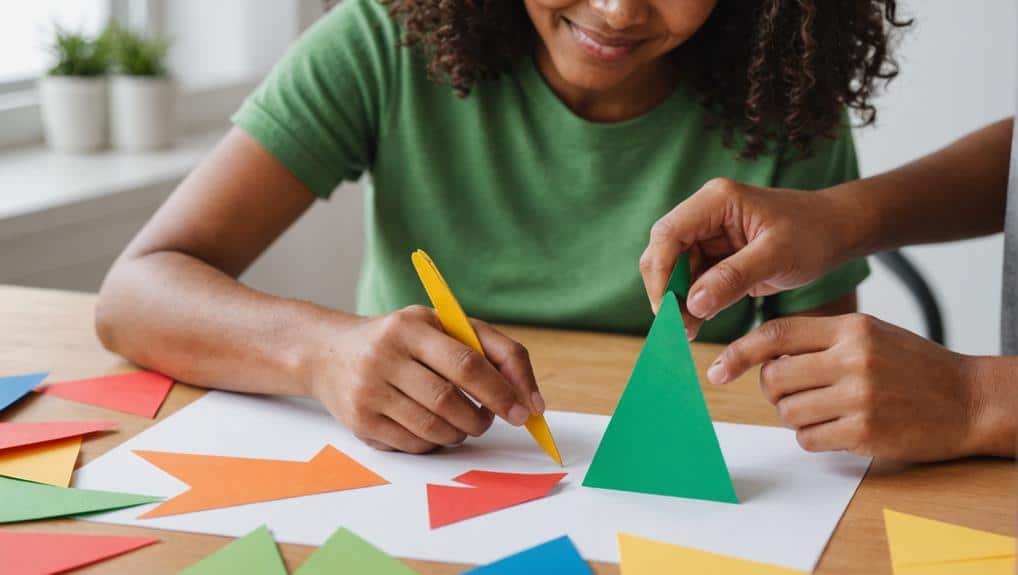
While the benefits of developing fine motor skills are vast, parents’ role in this process cannot be overemphasized. Parents are instrumental in creating a supportive environment that encourages children to explore and engage in activities that nurture fine motor skills development. Understanding and accepting autistic children’s distinct ways of doing things can significantly improve their skills development.
Their involvement can significantly impact a child’s hand-eye coordination, agility, and academic success. Engaging children in diverse activities helps build independence and enhances self-confidence. This is essential for all children, but especially for those with autism, who often struggle with self-understanding.
As parents, here are some ways you can boost your child’s fine motor skills:
- Engage your child in activities such as drawing or threading beads, which can be integrated into daily routines.
- Provide consistent practice to help your child master delicate motor tasks.
- Encourage independence by allowing your child to perform tasks on their own.
- Create a supportive environment that promotes exploration and learning.
Incorporating Playdough Activities
Incorporating playdough activities into a child’s routine can significantly improve their fine motor skills. As children knead and shape the dough, they enhance their hand strength and coordination and engage in crucial sensory exploration. Early diagnosis and intervention, such as playdough activities, can lead to improved long-term outcomes for children, particularly those with autism. These activities also foster their creativity and imagination, making playdough a valuable tool for their development.
Benefits of Playdough Play
Exploring the world of playdough can be a highly beneficial activity for children, especially in developing their fine motor skills. Manipulating the dough—pinching, rolling, flattening—naturally improves hand strength and coordination. Just like the practices recommended for individuals with autism during holiday gatherings, these playdough activities require finger dexterity that helps children develop precision in their movements. Playdough can also act as sensory support, assisting children in understanding and managing their tactile experiences better.
Here are some of the key benefits of incorporating playdough into your child’s play routine:
- Fosters Creativity: Playdough activities encourage creativity and imagination, allowing children to express their ideas and feelings freely.
- Boosts Problem-solving Skills: As children navigate the challenges of molding and shaping the dough, their problem-solving skills are honed.
- Improves Hand-eye Coordination: Playdough can enhance hand-eye coordination and spatial awareness, critical skills for everyday tasks.
- Supports Sensory Exploration: Playdough play facilitates sensory exploration and tactile stimulation, promoting a better understanding of the world around them.
Playdough Sculpting Techniques
Mastering the art of playdough sculpting can significantly improve a child’s fine motor skills. The kneading, rolling, and molding involved in playdough sculpting effectively strengthen a child’s hand muscles. It also boosts hand-eye coordination, as a child must carefully observe and manipulate the dough to create their desired shapes. This aspect of playdough activities could be particularly beneficial for children on the autism spectrum, as it provides an alternative way to develop focus without the pressure of eye contact.
Children can create intricate designs and increase their manual dexterity Using tools such as rolling pins, cookie cutters, and plastic knives. These tools add another layer of complexity to the activity and foster creativity and problem-solving skills.
Incorporating playdough sculpting into daily routines can be beneficial in developing patience, focus, and attention to detail. It encourages children to pursue a task until completion, instilling a sense of achievement and self-confidence.
Additionally, playdough activities provide a therapeutic and calming experience. The tactile nature of playdough aids in sensory exploration, allowing children to experience different textures and pressures. This sensory play can be constructive in stress relief and mood regulation, making playdough sculpting a valuable tool in a child’s overall growth.
Encouraging Scissor Use
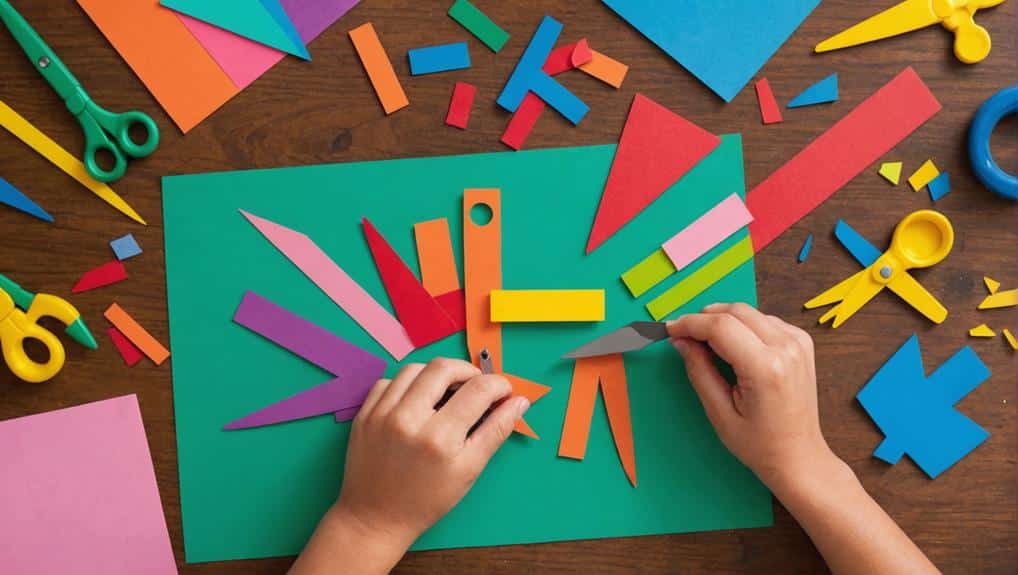
Cutting with scissors plays a significant role in the trajectory of fine motor skills development in children. Not only does it strengthen hand muscles and improve coordination, but it also bolsters confidence in handling tools effectively. The ensuing discussion will focus on facilitating safe scissors activities for children and methods for tracking their cutting progress.
Safe Scissor Activities
The development of fine motor skills in children often involves the use of tools like scissors. Supervised scissor activities improve hand-eye coordination and muscle strength and increase their cutting precision. To ensure safety during these activities, it is vital to use child-safe scissors with rounded tips.
Scissor activities should be seen as a fun and engaging process. Here are some strategies to involve your children in safe scissor activities:
- Encourage children to cut different materials like paper, playdough, or straws. This will improve their scissor control and agility.
- Start with straight lines and gradually introduce curves and intricate shapes to enhance cutting accuracy.
- Make scissor activities a regular part of their playtime. Consistent practice aids in the development of fine motor skills.
- Always supervise your children during scissor activities to ensure safety and provide guidance where needed.
Tracking Cutting Progress
Monitoring a child’s cutting advancement can significantly boost their confidence and motivation in developing scissor abilities. Recording the kinds of lines and shapes a child cuts provides proof of progress. Likewise, building a cutting skills collection can visually represent the child’s growing scissor proficiency.
Rating scales can be an effective tool for illustrating a child’s growth areas in scissor use. They help convert subjective observations into objective data, allowing for more accurate progress tracking. The rating process informs the child’s skill level and indicates where further practice is needed.
Observation is crucial in tracking improvements in scissor control, a key component of fine motor skill development. Observing a child’s progress in mastering scissor skills can offer insights into the pace of their advancement, their strengths, and the areas where they may need more support.
Introducing Bead Threading
Have you ever wondered how bead stringing can boost your child’s fine motor skills? This simple activity offers a variety of benefits, promoting hand-eye coordination, finger agility, and creativity. It’s a versatile approach to fine motor skills development, motivating children to interact with small objects in a focused and intentional manner.
Primarily, bead stringing:
- Improves hand-eye coordination as children guide the bead onto the string.
- Refines finger agility, as precision and control, are necessary to string the bead successfully.
- Promotes interaction with small objects, teaching children how to handle them effectively.
- It nurtures creativity, as children can craft distinct patterns and designs.
Building Blocks and Puzzles
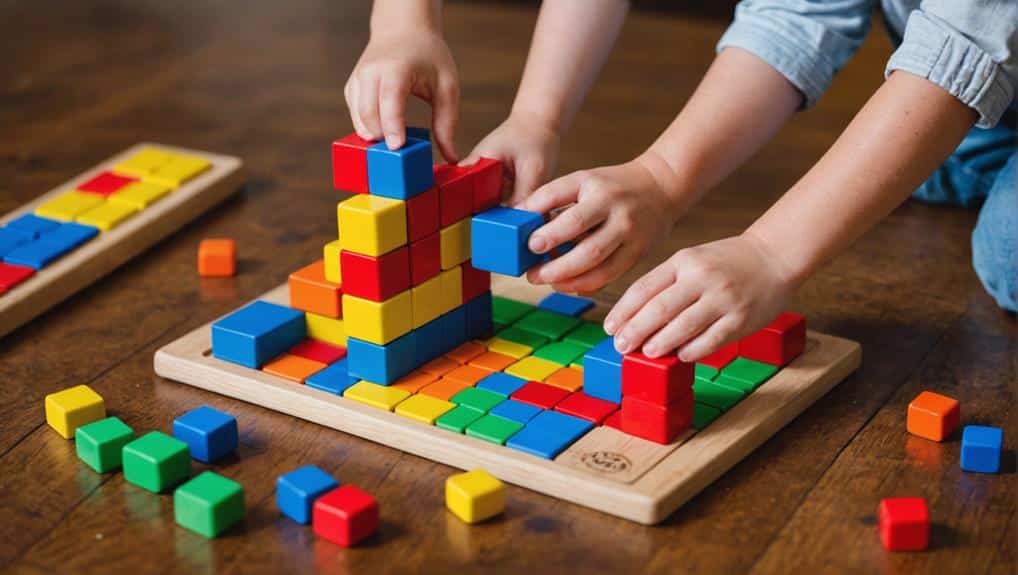
Mastering the art of building blocks and puzzles can significantly improve a child’s fine motor skills development. These tools are entertaining and educational, allowing children to enhance their hand-eye coordination, spatial awareness, and problem-solving abilities.
These activities offer two benefits: Strengthening finger dexterity and muscle control and encouraging cognitive skill development. Building blocks and puzzles’ versatility allows them to be adjusted to different skill levels and ages, making them valuable assets in supporting a child’s growth and development.
Engaging children in building blocks and puzzles can significantly improve their fine motor skills and problem-solving capabilities. Below is a table highlighting these benefits:
| Activity | Skills Developed | Benefits |
|---|---|---|
| Building Blocks | Fine Motor Skills, Hand-Eye Coordination | Develops muscle control, spatial awareness |
| Puzzles | Fine Motor Skills, Problem-Solving Skills | Encourages cognitive challenges, strengthens finger dexterity |
Crafting With Pipe Cleaners
While it may seem like mere play, crafting with pipe cleaners can improve a child’s fine motor skills; this adaptable and enjoyable activity allows children to refine these skills through twisting, bending, and shaping pipe cleaners; simultaneously, it strengthens hand-eye coordination and finger agility and stimulates creativity as children create different shapes, animals, or objects with these colorful tools.
Additionally, pipe cleaners provide a user-friendly, safe material for children while allowing them to practice their fine motor skills. This hands-on approach to learning will enable them to engage in imaginative and artistic projects.
Through crafting with pipe cleaners, children can:
- Refine their hand-eye coordination by aligning their vision with their hand movements.
- Improve finger agility through the delicate movements required in twisting and shaping pipe cleaners.
- Develop their hand muscles, which are crucial for writing and using tools effectively.
- Elevate their creativity by designing and creating a variety of shapes or objects.
Importance of Drawing and Coloring
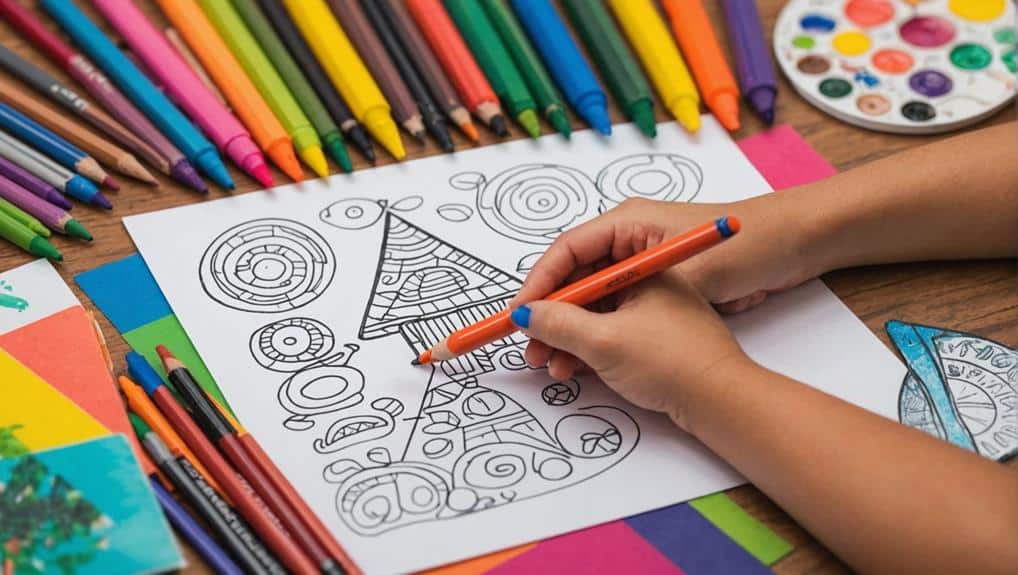
Indeed, drawing and coloring activities play a significant role in fostering fine motor skills development in children. These activities improve hand-eye coordination and finger dexterity. As your child moves the crayon or pencil across the paper, they create art and strengthen the small muscles in their hands.
Drawing and coloring tasks encourage creativity and imagination. As children experiment with different colors and shapes, they also learn about the world around them. This creative exploration can enhance self-confidence as they see their creations come to life.
Moreover, these activities improve focus, patience, and attention to detail. Drawing and coloring require children to pay attention to the task, fostering concentration and patience.
These fine motor skills can boost academic performance, especially in writing and spatial awareness activities. Here’s a quick summary:
| Benefit | Explanation | Impact |
|---|---|---|
| Hand-eye coordination | Moving the crayon involves tracking the movement with the eyes. | Improves overall fine motor skills. |
| Creativity | Experimenting with colors stimulates imagination. | Strengthens self-confidence and cognitive development. |
| Focus | Requires attention to detail. | Cultivates concentration and patience. |
| Academic performance | Fine motor skills aid in writing and spatial tasks. | Contributes to academic success. |
Practical Tasks: Buttoning and Zipping
Engaging in practical tasks such as fastening and closing improves children’s fine motor skills and equips them with vital life skills. Fastening and closing require precision and control, enhancing hand-eye coordination and finger dexterity. This prepares children for more intricate fine motor activities and fosters a sense of independence, improving their self-esteem and confidence.
Empowering children to manage these tasks independently is indispensable, and there are several strategies parents can use to encourage this:
- Start Early: Introduce fastening and closing tasks early, using toys or clothes with large buttons and zippers.
- Break it Down: Simplify the task into smaller steps and gradually increase complexity as their skills improve.
- Consistent Practice: Regular practice is vital to mastery. Please encourage your child to dress themselves daily.
- Positive Reinforcement: Celebrate their successes, no matter how small, to elevate their confidence.
Exploring Clay Sculpting
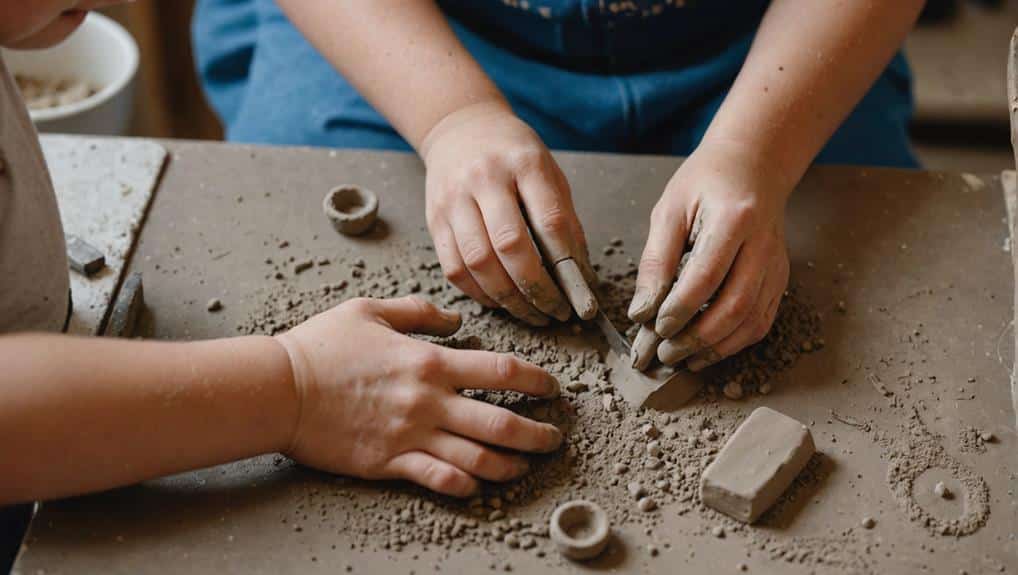
Clay sculpting offers a distinctive approach to developing fine motor skills in children. This section will discuss different clay sculpting techniques, their benefits, and vital safety measures to keep in mind during the activity. The aim is to emphasize how clay sculpting improves motor skills and stimulates children’s creativity, spatial awareness, and self-confidence.
Clay Sculpting Techniques
The technique of clay sculpting is unique and remarkable in honing fine motor skills. It improves these skills by utilizing hand-eye coordination and finger dexterity. Additionally, it allows children to express their creativity and imagination by shaping and molding clay into diverse forms.
Fundamental techniques in clay sculpting that promote fine motor skills development include:
- Pinching and squeezing: These actions develop finger skills and strength, which are vital for writing and other detailed tasks.
- Rolling and flattening: These movements enhance hand-eye coordination, which is necessary for many everyday activities.
- Shaping and molding: These tasks improve sensory processing skills as children use different textures and shapes.
- Designing and detailing: These activities promote patience and focus as children work on intricate details with the clay.
Clay sculpting provides a versatile and engaging way for children to develop fine motor skills while enjoying a hands-on artistic experience. As a parent, these methods can be pivotal in fostering your child’s development.
Benefits of Clay Sculpting
Clay sculpting utilizes the malleability of this adaptable material, and children derive manifold benefits from it. This hands-on activity improves fine motor skills by promoting hand-eye coordination and finger dexterity. As children manipulate the clay, their hand muscles strengthen, improving the precision necessary for different delicate motor tasks.
Clay sculpting encourages creativity, allowing children to express their imagination while refining their motor skills. Transforming a lump of clay into a tangible object provides a platform for children to experiment, innovate, and create. It fosters patience, focus, and attention to detail, all crucial life skills.
Beyond the physical benefits, clay sculpting offers a rich sensory experience. It stimulates tactile awareness as children feel the clay’s texture, temperature, and weight. This hands-on activity promotes sensory integration, helping children to understand and respond appropriately to their environment.
Clay Sculpting Safety Measures
While clay sculpting has numerous benefits for children, it is essential to consider the safety measures necessary during this engaging activity. Parents and caregivers must ensure that the clay used is non-toxic and child-friendly. This basic precast is essential to encourage free exploration without causing unnecessary worry.
Children, especially young ones, must always be supervised during clay sculpting. This helps prevent accidents and provides an opportunity to guide them in handling tools properly.
Here are some key measures to remember:
- Use only safe and child-friendly clay for sculpting.
- Supervise children closely during the activity to prevent clay ingestion and improper use of tools.
- Teach children the importance of proper handwashing after clay sculpting to avoid potential health risks.
- Provide age-appropriate sculpting tools to prevent injuries and stimulate creativity.
Moreover, always store clay and sculpting tools outside children’s reach when not in use. By taking these precautions, we can ensure children’s safe and enriching clay sculpting experience and promote their fine motor skills development in a secure environment.
Enhancing Skills Through Sorting Games
Sorting games are practical tools for refining fine motor skills in children. They encompass a variety of activities that require precise hand movements, fostering the development of hand-eye coordination and spatial awareness. By categorizing objects based on size, color, shape, or category, children learn to distinguish different attributes and improve their cognitive skills and concentration.
The act of organizing and categorizing aids in improving problem-solving abilities. Children engaged in sorting games naturally need to apply critical thinking to determine where each item belongs. This logical reasoning and decision-making process is instrumental in developing their cognitive abilities.
Moreover, sorting games promote finger dexterity, a critical aspect of fine motor skills. The repeated motion of picking up, maneuvering, and placing objects provides ample opportunity for children to strengthen their finger muscles, enhancing their overall motor skills development.
Monitoring Development Progress
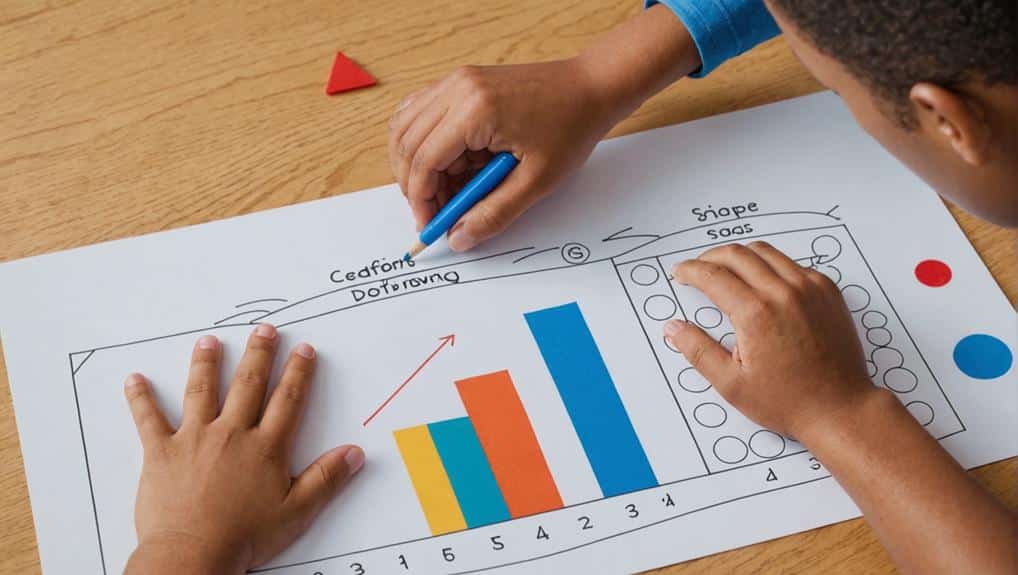
Tracking the child’s progress becomes important after developing fine motor skills through activities like sorting games. Monitoring progress is essential in ensuring a child is on track in their growth and development.
To systematically monitor the child’s progress, use progress charts to document improvements. They are an effective tool that records the child’s advancements in techniques over time. Observing the passage of the child’s development gives you insights into their growth and mastery of fine motor skills.
Following are some specific techniques to help in documenting improvements:
- Keep a portfolio of the child’s work in activities such as threading beads, puzzle assembly, and drawing.
- Monitor advancements in buttoning, zipping, and clay sculpting techniques.
- Implement cutting exercises and sewing projects to track the progression of fine motor skills.
- Use rating scales to evaluate the child’s skill level in specific areas.
Tools and Safety Considerations
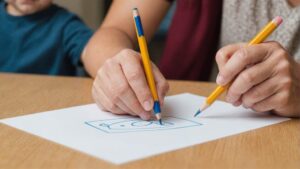 The choice of tools and safety considerations play a pivotal role in enhancing a child’s fine motor skills. Carefully selected tools can significantly contribute to a child’s motor skills development, and attention to child safety can guarantee a productive and worry-free learning environment. Rounded-tip scissors with blade guards, for instance, guarantee safe cutting activities and reduce the risk of accidents. Bead threading and sewing projects, while excellent for honing fine motor skills, require adult supervision to prevent choking or puncture hazards. Tools with comfortable handles, like pipe cleaners, tweezers, and tongs, improve the child’s control and grip and help avoid injuries from mishandling.
The choice of tools and safety considerations play a pivotal role in enhancing a child’s fine motor skills. Carefully selected tools can significantly contribute to a child’s motor skills development, and attention to child safety can guarantee a productive and worry-free learning environment. Rounded-tip scissors with blade guards, for instance, guarantee safe cutting activities and reduce the risk of accidents. Bead threading and sewing projects, while excellent for honing fine motor skills, require adult supervision to prevent choking or puncture hazards. Tools with comfortable handles, like pipe cleaners, tweezers, and tongs, improve the child’s control and grip and help avoid injuries from mishandling.
Clay sculpting is another exciting activity that promotes motor skill development. However, guidance and supervision are required to handle oils and materials safely.
While attention to tools and safety is paramount in developing a child’s fine motor skills, it’s equally essential to acknowledge and address any developmental challenges that may arise in this process. Early identification and intervention can significantly impact a child’s growth and success. Tailored strategies and personalized support, often provided through pediatric occupational therapy, can help children overcome such challenges and reach their full potential.
- Pediatric Occupational Therapy: Collaborating with professionals can provide targeted interventions to address specific developmental challenges.
- Tailored Strategies: Personalized approaches designed to suit a child’s distinct needs can significantly improve the development of fine motor skills.
- Personalized Support: Continuous, individualized encouragement and guidance can foster a child’s confidence and motivation to improve.
- Positive Reinforcement: Consistent practice combined with positive reinforcement is crucial in helping children improve their fine motor skills.
Addressing developmental challenges early on can prevent long-term impacts on a child’s academic and social development. As parents, we provide the necessary support and resources to ensure our children can overcome any obstacle and thrive.
Frequently Asked Questions
How Can Parents Promote Fine Motor Skills?
Parents can nurture fine motor skills by incorporating activities that improve finger dexterity and hand-eye coordination. These can include playdough sculpting, puzzles, drawing, and using tools like safe scissors, tweezers, and tongs in day-to-day tasks.
What Fine Motor Skills Should a 15-Year-Old Have?
A 15-year-old should display advanced fine motor skills, such as precise handwriting, hand-eye coordination for playing instruments, typing and using digital devices, and the ability to handle intricate crafting tasks.
What Are 3 Ways to Encourage Children’s Development in Small Motor Skills?
Engage children in activities like sculpting with playdough, threading beads, and buttoning clothes to foster their small motor skills development. Encourage cutting exercises to develop scissor skills and use building blocks for hand-eye coordination.
What Fine Motor Skills Should a 13-Year-Old Have?
A 13-year-old should display improved fine motor skills, including precise handwriting, intricate drawing, proficient use of tools like scissors, and demonstrate refined hand-eye coordination, agility, and controlled movements for complex tasks.
Conclusion
To sum up, fine motor skills development in children is an essential aspect of their overall growth and academic success. Adopting the abovementioned strategies can significantly improve these skills, nurturing independence and confidence. Like the sculptor who carefully sculpts a masterpiece, these strategies slowly hone a child’s abilities, paving the way for completing tasks and activities. Therefore, parents and caregivers must consistently support this fundamental facet of child development.


Recent Comments